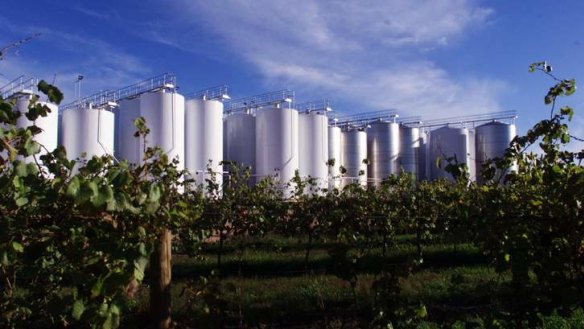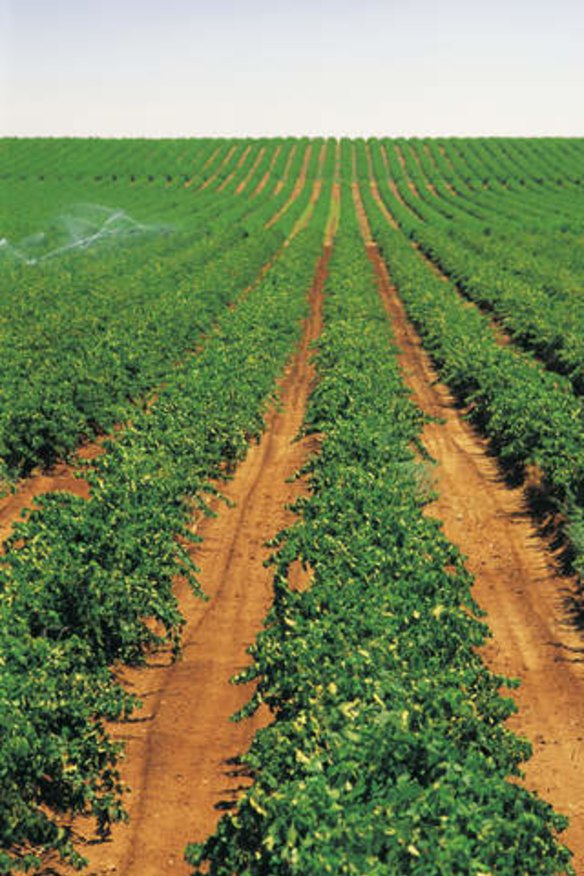South Australian Riverland is big, bold and mind-boggling
The sheer scale of Riverland wines helps it deliver supersized value.

We drove around the Berri Estates winery in a bus, not just because it was raining, but because it's so big. It's the second biggest winery in the world, after California's Gallo, winemaker Paul Burnett proudly declared. "We've had a big vintage, we're chockers," he says. "We put through 230,000 tonnes."
You could almost hear a collective "Gulp!" from wine writers on the bus.
"Our most common tank size is 278,000 litres. We'd do all of Tassie in a single day. Grapes arrive in 25-tonne trucks. We have 100-tonne fermenters."

Then, as if reading our minds, he deadpans: "Can you feel the soul?" And brings the house down.
Yes, the South Australian Riverland is big. Very big.
At Kingston Estate, the winery looks like a town, but it's almost boutique after Berri: a mere 90,000 tonnes crush. But they have bigger fermenters and tanks: 200-tonne fermenters and the biggest tank holds 365,000 litres.
Owner Bill Moularadellis doesn't try to make it sound glamorous. "One-quarter of Australia's wine grapes are grown within a 40-kilometre radius of here. Six per cent of Australia's wine comes out of this winery, and 8.8 per cent of Australia's exports (by volume)." He shows us crushers that can crush 90 tonnes of grapes an hour, and a bottling line that fills 10,000 bottles an hour.
Moularadellis is expert at putting us in the picture; giving the wine media a much-needed dose of reality.
"We have a warm, dry climate here, which is great for consistency. Consumers of our wine are less engaged with wine than you and your peers are. We are mindful of making wines they enjoy rather than wines we enjoy. We make wines for Monday to Thursday, and there's a big market for them. We sell a quarter of a million bottles of wine every day."
We're talking $10 to $15 wine here, or cheaper. Yalumba's Oxford Landing ballpark. Banrock Station ballpark. Angove's Long Row and Nine Vines ballpark. These are wines made in large licks, exported to the world, and selling for a song in a shop near you. And they are very good value for money. I doubt there's another country that competes with the quality/price ratio.
Even the small wineries such as Basshams, Whistling Kite, 919 Wines and Mallee Estate are inexpensive. And often very good. Yalumba Y Series Vermentino 2012; Bassham Montepulciano 2012, Nero d'Avola 2013 and Fiano 2013; Banrock Station Montepulciano 2012; Whistling Kite Unwooded Chardonnay 2012, Shiraz 2012 and Petit Verdot 2010; and Growers Gate Shiraz 2012 were some of the highlights. Kingston Estate 2014 Vermentino, not yet in the bottle, was tremendously promising. It will be their first release of that variety; not a tentative first step, but 20,000 litres!
The Riverland has changed, is still changing. It now uses less water to irrigate its vines. Most of the irrigation is done by efficient under-vine drippers. Yields are more restrained. And grape varieties are changing. There's a lot more of the Mediterranean varieties being grown: vermentino, fiano, viognier and grillo for white wines; tempranillo, montepulciano, nero d'avola and petit verdot for reds.
Moularadellis again articulates the position: "The majority of wine that is produced and drunk in the world is from warmer climates, but the leading image and quality varieties are the benchmarks produced in cooler climates.
''As we see more and more wine produced in warm climates - partly because of global heating - we will see more of it being made from varieties that suit those regions." He singled out grenache, mourvedre, tempranillo, malbec and petit verdot. "We can't be faddish; it has to be based on substance. At Kingston Estate our long-term commitment to petit verdot will continue."
Kingston has been producing petit verdot for 20 years: it made the judgment in the '90s that PV was ''head and shoulders'' above other varieties in the region, and boldly planted a single vineyard of 100 hectares. Today it makes several pure varietal wines as well as using PV to improve cabernet, shiraz and merlot wines.
Another exciting development in Riverland is the emergence of organic and biodynamic viticulture. Angove has for several years marketed a range of Riverland wines labelled organic, and Whistling Kite is biodynamically certified.
The owners, Pam and Tony Barich, must sometimes feel isolated in a region dominated by corporate wineries and broadacre farming, but they have a niche market and their wines are good. Given the region's very dry climate (and low disease pressure) it's surprising there isn't more of a movement towards sustainable grapegrowing. It will come.
Yalumba, ever the pioneer and innovator, has its large 250-hectare Oxford Landing vineyard there. All of its fermentations are ''wild'', which means it has to take special care in the vineyard to avoid killing off the native yeasts: no pesticides and no chemicals that could inhibit natural fermentation. Its labels also proclaim the wines ''vegan friendly'': no animal products (e.g. eggs, milk or other animal protein) are used for fining.
I was most impressed with an Oxford Landing merlot and sauvignon blanc, both unbottled samples from the 2014 vintage. Notwithstanding the trend towards Mediterranean varieties, these are really remarkable wines, all the more so considering the $9.50 price-tag.
■ The South Australian Riverland, also known as the Lower Murray region, encompasses the Murray River between Renmark and Blanchetown, including Berri, Loxton, Barmera, Waikerie and Morgan.
